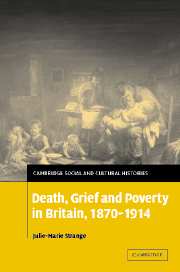Book contents
- Frontmatter
- Contents
- Acknowledgements
- List of abbreviations
- 1 Introduction: revisiting the Victorian and Edwardian celebration of death
- 2 Life, sickness and death
- 3 Caring for the corpse
- 4 The funeral
- 5 Only a pauper whom nobody owns: reassessing the pauper burial
- 6 Remembering the dead: the cemetery as a landscape for grief
- 7 Loss, memory and the management of feeling
- 8 Grieving for dead children
- 9 Epilogue: death, grief and the Great War
- Bibliography
- Index
7 - Loss, memory and the management of feeling
Published online by Cambridge University Press: 05 July 2009
- Frontmatter
- Contents
- Acknowledgements
- List of abbreviations
- 1 Introduction: revisiting the Victorian and Edwardian celebration of death
- 2 Life, sickness and death
- 3 Caring for the corpse
- 4 The funeral
- 5 Only a pauper whom nobody owns: reassessing the pauper burial
- 6 Remembering the dead: the cemetery as a landscape for grief
- 7 Loss, memory and the management of feeling
- 8 Grieving for dead children
- 9 Epilogue: death, grief and the Great War
- Bibliography
- Index
Summary
The preceding chapters have explored responses to bereavement that centred on the principal artefacts of death: the corpse, the funeral and the grave. It remains, therefore, to examine how normative grief was defined by the working classes; how loss found verbal and symbolic expression outside burial rites; and the ways in which the dead were remembered once they had been laid to rest. Little research has been conducted since David Vincent concluded, in the early 1980s, that working-class responses to bereavement were shaped by material circumstance. There are, however, several problems with the assumption that poverty precluded ‘pure’ grief. First, it is not inevitable that the relationship between poverty and death should limit grief. The two could operate together to create an overriding sense of desolation and despair. Likewise, the reverse was sometimes true: poverty might exacerbate the anguish of loss. Secondly, Vincent's use of the phrase ‘pure grief’ is evasive: he fails to clarify his definition of this term and, moreover, omits to identify those who did register this experience. Implicit in Vincent's narrative is an assumption that unfettered emotion was an ideal and privileged form of bereavement. That the working classes had not the ‘luxury’ to develop or indulge this heightened sensibility intimates that they were denied access to models of good grief available to those in wealthier circumstances.
This chapter advances a more flexible understanding of responses to bereavement.
- Type
- Chapter
- Information
- Death, Grief and Poverty in Britain, 1870–1914 , pp. 194 - 229Publisher: Cambridge University PressPrint publication year: 2005
- 1
- Cited by



